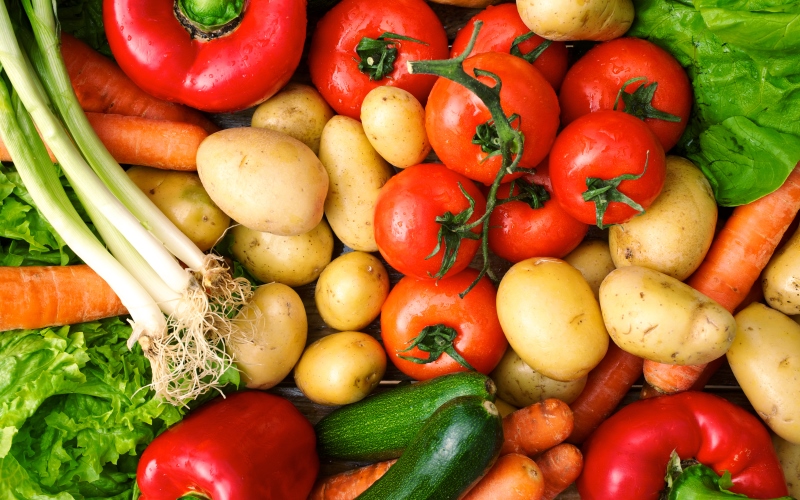June 30, 2020
An Early Season Check-in for Northeast Fruit and Vegetables Markets: The impacts of COVID-19 and beyond
By: Chris Laughton

If there is anything to be learned from the COVID-19 pandemic and its impact on Northeast fruit and vegetable markets, it is that there is not a single “food system,” but rather “multiple crisscrossing supply chains, some connected, some not,” stated Dr. Bradley Rickard, of Cornell University, in a recent webinar held by Farm Credit East.
The start of the 2020 growing season has been unlike any other. While some retail fruit and vegetable sales have surged recently due to the COVID-19 crisis, this increase has not been uniform across all product categories, and some products have experienced a greater boost than others.
The COVID-19 pandemic has created a paradox of shortages among some items in retail grocery stores, while at the same time, dumped and wasted product at the farm level. According to Dr. Gomez, of Cornell University, there are several factors contributing to these problems — most significantly the loss of most food service markets due to the shutdown of restaurants, schools and many other institutions. Additional factors include labor challenges, including the health of workers in packing and processing facilities.
Supply and Demand
COVID-19 has disrupted both supply as well as demand. The greatest impact has been on the processing sector, creating bottlenecks and resulting in lower farm prices and higher consumer prices simultaneously. This has been most noticeable in the meat sector but has affected fruits and vegetables as well.
Changing consumer preferences
In April 2020, compared to April 2019, food service and drinking establishments saw a 53% decline in business volume. Conversely, grocery stores and warehouse clubs saw a surge in business as consumers shifted to meals at home.
Additionally, many consumers are making less frequent grocery store visits and buying more per visit. More consumers are also shifting purchases online for delivery or store pick-up.
The products purchased have also shifted somewhat, with some people purchasing more basic foods than higher-end products and switching between brands. In response, growers and suppliers have been making changes in products offered and how they can be purchased.
At the same time, retailers have increased their attention to worker safety and redesigned stores to protect both customers and staff. This has resulted in many companies in the food supply chain reporting that while sales have increased in some cases, so have costs.
Increased costs
Just as grocery chains are experiencing increased costs, the changes agricultural businesses have had to employ in response to the coronavirus have also added costs. Some operations have implemented home delivery, pre-boxing assortments or online ordering options. In some cases, these changes have increased the labor required. Additionally, some farms have struggled with technology and internet access in rural areas.
Direct-to-consumer
Fruit and vegetable sales have been very strong, particularly for CSA shares. Prices have mostly held steady, but many farms have seen an increase in produce volume, leading some wholesale growers to divert products to retail markets.
Still, not everyone has seen such increases. Some farms have struggled, particularly those who rely on CSA distribution at companies or churches, many of which have shut down or reduced capacity. Others have not gone to markets in New York City, for example, and lost that outlet.
There has also been a considerable impact on agritourism. In New York, more than 800 farms have agritourism ventures, which is over-and-above direct marketing and pick-your-own. This is particularly significant for Long Island and farms near urban centers. Some of this activity may be curtailed this year.
Labor challenges
Management changes and risk avoidance, the importance of planning, and the ability to secure a sufficient workforce are some of the significant labor issues related to COVID-19.
How to avoid and manage the risk of COVID-19 spread among workers as well as related lawsuits is a significant concern. Worker’s compensation provides some measure of protection, but it’s not complete, and lawsuits can still happen.
Reputation risk is another concern. Some New York businesses have had outbreaks among their workers. In some of these cases, the COVID-19 prevention measures in the workplace were sufficient, but worker housing was a weak point.
If an outbreak does occur, producers want to be able to point to robust COVID-19 prevention practices at their business. However, not everything can be prevented, and employees interact with others outside of work as well. There is always a chance that community spread can still occur.
Some important actions to reduce risk are:
- Review and understand your insurance coverages
- Follow guidance of government authorities
- Train employees
- Follow up to ensure compliance – a written policy does nothing if it’s not followed and enforced
- Document decisions and actions with dates
- Stay vigilant and have a plan if employees get sick
For the Cornell Cooperative Extension online resources on how farms can keep their businesses safe, visit Agworkforce.cals.cornell.edu. While this information is New York-focused, it is still worthwhile for those located elsewhere.
Looking forward
COVID-19 will not affect all fruit and vegetable markets the same way. Some will benefit, while others will be negatively impacted. For annual vegetable growers, there is a limited window to consider the trade-offs for producing different crops. Producers selling direct-to-consumer may have a significant opportunity to seize local and regional markets.
Growers and distributors will have to re-think some practices and increase collaborations and partnerships. Product packaging and selection as well as supply chains may shift. Technology will become increasingly important both for business-to-business relationships as well as business-to-consumer.
As far as the various relief programs, some, such as the Paycheck Protection Program, have been beneficial, but the USDA Coronavirus Food Assistance Program (CFAP) has not been a good fit for most Northeast producers.
Due to the shift in some consumer attitudes as a result of the pandemic, price may be more or less important depending on an individual’s circumstances. Additionally, the pandemic’s impact on consumers’ incomes and rising food prices may continue to push a shift from “fancy” to “basic” food options. Storability has also become more important, and everyone seems to be seeking greater value.
Food assistance programs may need to be strengthened. Food hubs sourcing local and regional foods are likely to grow, as are “hard discounters” such as ALDI and dollar stores. Getting more Northeast products into these outlets is a concern.
In summary, demand for fruits and vegetables is strong and many growers will have a good season in 2020. However, it will not be without challenges. Keeping workers and customers safe from the virus is chief among them. Various restrictions from federal, state and local governments will be a factor and then, of course, weather is always a large variable.
The above information was summarized from a webinar Farm Credit East held on June 25, 2020, in conjunction with the New York State Vegetable Growers Association. The webinar featured four presenters from Cornell University and Cornell Cooperative Extension: Dr. Miguel Gomez, professor of food marketing; Dr. Bradley Rickard, associate professor in applied economics and management; Dr. Richard Stup, agricultural workforce specialist; and Elizabeth Higgins, business management specialist. To view the full recording of this webinar along with the accompanying presentation, click here.




